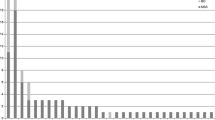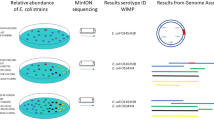Abstract
From the Camelidae family members, several serotypes of Escherichia coli (E. coli) have recently been isolated from diarrhoeic and non-diarrhoeic faecal samples. To date Shiga toxin-producing E. coli (STEC) strains have never been typed in one-humped camel (Camelus dromedarius). In the present study, two E. coli O157:H7 strains isolated from sick dromedaries were investigated. Virulence gene profiles were determined using a custom E. coli virulence DNA microarray, composed of 70-mer oligonucleotide probes targeting 264 virulence or related genes of known E. coli pathotypes. Both strains displayed positive hybridization signals for the Locus of enterocyte effacement (LEE) gene probes (ler, eae, espA, espB, tir genes), two Shiga toxin probes (stx1 and stx2), the O157 O-antigen specific probe, various virulence plasmid (pO157) probes like katP in addition to other accessory virulence genes characterized in STEC.
Similar content being viewed by others
References
Clermont, O., Bonacorsi, S., & Bingen, E. (2000). Rapid and simple determination of the Escherichia coli phylogenetic group. Applied and Environmental Microbiology, 66, 4555–4558.
Kaper, J. B., Nataro, J. P., & Mobley, H. L. (2004). Pathogenic Escherichia coli. Nature Reviews Microbiology, 2, 123–140.
Karpac, C. A., Li, X., Terrell, D. R., Kremer Hovinga, J. A., Lammle, B., Vesely, S. K., et al. (2008). Sporadic bloody diarrhoea-associated thrombotic thrombocytopenic purpura-haemolytic uraemic syndrome: an adult and paediatric comparison. British Journal of Haematology, 141, 696–707.
Naylor, S. W., Gally, D. L., & Low, J. C. (2005). Enterohaemorrhagic E. coli in veterinary medicine. International Journal of Medical Microbiology, 295, 419–441.
Karmali, M. A. (2004). Infection by Shiga toxin-producing Escherichia coli: an overview. Molecular Biotechnology, 26, 117–122.
Sheng, H., Lim, J. Y., Knecht, H. J., Li, J., & Hovde, C. J. (2006). Role of Escherichia coli O157:H7 virulence factors in colonization at the bovine terminal rectal mucosa. Infection and Immunity, 74, 4685–4693.
Dunn, J. R., Keen, J. E., & Thompson, R. A. (2004). Prevalence of Shiga-toxigenic Escherichia coli O157:H7 in adult dairy cattle. Journal of the American Veterinary Medical Association, 224, 1151–1158.
Salmanzadeh-Ahrabi, S., Habibi, E., Jaafari, F., & Zali, M. R. (2005). Molecular epidemiology of Escherichia coli diarrhoea in children in Tehran. Annals of Tropical Paediatrics, 25(1), 35–39.
Jafari, F., Garcia-Gil, L. J., Salmanzadeh-Ahrabi, S., Shokrzadeh, L., Aslani, M. M., Pourhoseingholi, M. A., et al. (2009). Diagnosis and prevalence of enteropathogenic bacteria in children less than five years of age with acute diarrhea in Tehran children’s hospitals. Journal of Infection, 58(1), 21–27.
Bonyadian, M., Momtaz, H., Rahimi, E., Habibian, R., Yazdani, A., & Zamani, M. (2010). Identification and characterization of Shiga toxin-producing Escherichia coli isolates from patients with diarrhea in Iran. Indian Journal of Medical Research, 132, 328–331.
Aslami, M. M., & Bouzari, S. (2009). Characterization of virulence genes of non-O157 Shiga toxin-producing Escherichia coli isolates from two provinces of Iran. Japanese Journal of Infectious Diseases, 62(1), 16–19.
Badouei, M. A., Salehi, T. Z., Khorasgani, M. R., Tadjbakhsh, H., Brujeni, G. N., & Nadalian, M. G. (2010). Virulence gene profiles and intimin subtypes of Shiga toxin-producing Escherichia coli isolated from healthy and diarrhoeic calves. Veterinary Record, 167(22), 858–861.
Tahamtan, Y., Hayati, M., & Mehdi Namavari, M. (2010). Contamination of sheep carcasses with verocytotoxin producing Escherichia coli during slaughtering. Transboundary and Emerging Diseases, 57(1–2), 25–27.
Shuchismita Chatterjee Kashyap, S. K. (2005). Pathogenicity testing of Escherichia coli isolates of livestock and poultry. Veterinary Practitioner, 6(2), 105–108.
Seleim, R. S., & El-Sebaey, W. A. F. (2004). Camel-calves diarrhoea instigated by Escherichia coli and detection of some virulence-associated markers. Veterinary Medical Journal Giza, 52, 153–163.
El-Sayed, A., Ahmed, S., & Awad, W. (2008). Do camels (Camelus dromedarius) play an epidemiological role in the spread of Shiga Toxin producing Escherichia coli (STEC) infection? Tropical Animal Health and Production, 40, 469–473.
Moore, J. E., McCalmont, M., Jiru, Xu, Nation, G., Tinson, A. H., Crothers, L., et al. (2002). Prevalence of faecal pathogens in calves of racing camels (Camelus dromedaries). Tropical Animal Health and Production, 34, 283–287.
Featherstone, C. A., Foster, A. P., Chappell, S. A., Carson, T., & Pritchard, G. C. (2011). Verocytotoxigenic Escherichia coli O157 in camelids. Veterinary Record, 168, 194–195.
Lim, J. Y., Hong, J. B., Sheng, H., Shringi, S., Kaul, R., Besser, T. E., et al. (2010). Phenotypic diversity of Escherichia coli O157:H7 strains associated with the plasmid O157. Journal of Microbiology, 48, 347–357.
Lim, J. Y., Yoon, J., & Hovde, C. J. (2010). A brief overview of Escherichia coli O157:H7 and its plasmid O157. Journal of Microbiology and Biotechnology, 20, 5–14.
Wick, L. M., Qi, W., Lacher, D. W., & Whittam, T. S. (2005). Evolution of genomic content in the stepwise emergence of Escherichia coli O157:H7. Journal of Bacteriology, 187, 1783–1791.
Zhang, Y., Laing, C., Steele, M., Ziebell, K., Johnson, R., Benson, A. K., Taboada, E., & Gannon V. P. (2007). Genome evolution in major Escherichia coli O157:H7 lineages. BMC Genomics, 8, 121. http://www.biomedcentral.com/1471-2164/8/121.
Afset, J. E., Bruant, G., Brousseau, R., Harel, J., Anderssen, E., Bevanger, L., et al. (2006). Identification of virulence genes linked with diarrhea due to atypical enteropathogenic Escherichia coli by DNA microarray analysis and PCR. Journal of Clinical Microbiology, 44, 3703–3711.
Bruant, G., Maynard, C., Bekal, S., Gaucher, I., Masson, L., Brousseau, R., et al. (2006). Development and validation of an oligonucleotide microarray for detection of multiple virulence and antimicrobial resistance genes in Escherichia coli. Applied and Environmental Microbiology, 72, 3780–3784.
Hamelin, K., Bruant, G., El-Shaarawi, A., Hill, S., Edge, T. A., Bekal, S., et al. (2006). A virulence and antimicrobial resistance DNA microarray detects a high frequency of virulence genes in Escherichia coli isolates from great lakes recreational waters. Applied and Environmental Microbiology, 72, 4200–4206.
Tonelli, A., Badagliacca, P., Bruant, G., Letizia, A., Di Provvido, A., Harel, J, & Scacchia, M. (2008). Genetic characterization of rabbit Escherichia coli strains with the use of microarray technology. In Proceedings 9th World Rabbit Congress, Verona, Italy, June 10–13, 2008. World Rabbit Science Association, Valencia, Spain, 1097–1101.
Alonso, J. L., Soriano, A., Carbajo, O., Amoros, I., & Garelick, H. (1999). Comparison and recovery of Escherichia coli and thermotolerant coliforms in water with a chromogenic medium incubated at 41 and 44.5 °C. Applied and Environmental Microbiology, 65, 3746–3749.
Lim, J. Y., La, H. J., Sheng, H., Forney, L. J., & Hovde, C. J. (2010). Influence of plasmid pO157 on Escherichia coli O157:H7 Sakai biofilm formation. Applied and Environmental Microbiology, 76, 963–966.
Scheutz, F., Møller Nielsen, E., Frimodt-Møller, J., Boisen, N., Morabito, S., Tozzoli, R., Nataro, J.P, & Caprioli, A. (2011). Characteristics of the enteroaggregative Shiga toxin/verotoxin-producing Escherichia coli O104:H4 strain causing the outbreak of haemolytic uraemic syndrome in Germany, May to June 2011. Euro Surveillance, 16(24), 19889. http://www.eurosurveillance.org/ViewArticle.aspx?ArticleId=19889.
Acknowledgment
We thank Dr. Armando Giovannini of Istituto G. Caporale, Epidemiology unit, for his suggestions.
Author information
Authors and Affiliations
Corresponding author
Rights and permissions
About this article
Cite this article
Salehi, T.Z., Tonelli, A., Mazza, A. et al. Genetic Characterization of Escherichia coli O157:H7 Strains Isolated from the One-Humped Camel (Camelus dromedarius) by Using Microarray DNA Technology. Mol Biotechnol 51, 283–288 (2012). https://doi.org/10.1007/s12033-011-9466-7
Published:
Issue Date:
DOI: https://doi.org/10.1007/s12033-011-9466-7




